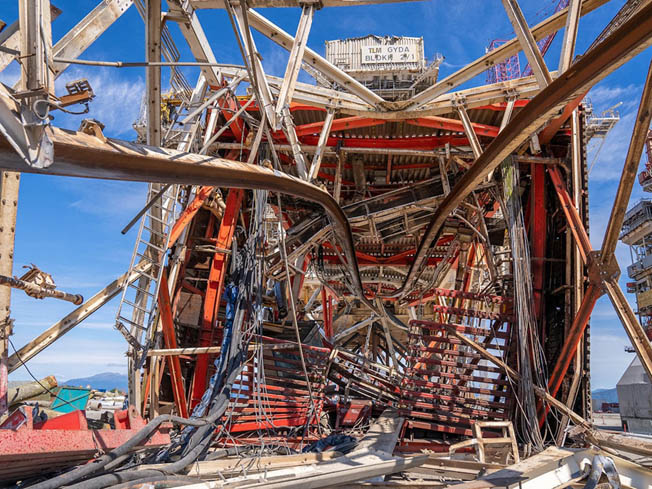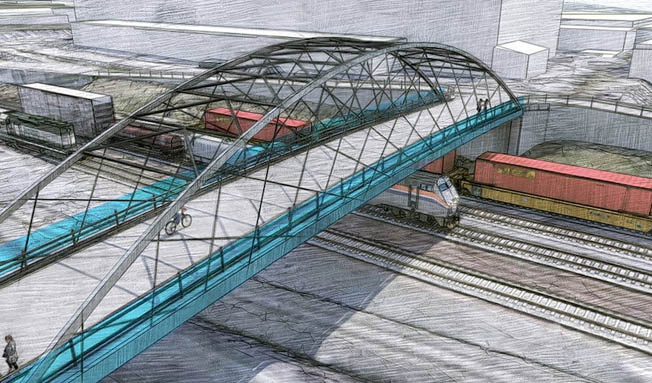Aluminium and renewable energy company Hydro is recycling and extruding 20 tonnes of scrap aluminium from a decommissioned oil platform in the North Sea. The aluminium, along with other discarded products, will be used in the construction of the new bridge, highlighting Hydro’s commitment to a circular economy.

The decommissioned oil platform Gyda, which was dismantled by Aker Solutions starting in 2022
Norway’s first aluminium bridge in the last three decades uses aluminium from a decommissioned rig and began construction in May 2024. The Hangarbrua pedestrian bridge spans 55 meters in length and 9 meters in width. It will cross the railway lines at Trondheim’s Leangen Station, and serve as part of the main pedestrian and bicycle road toward the city center. The Hangarbrua bridge is truly groundbreaking as its deck, an all aluminium network arch construction, will be the first of its kind in the world, consisting of 100 percent recycled aluminium. Only the tension rods will be made from stainless steel.
“This project embodies the future of sustainable construction, where the past is literally being transformed into the bridges of tomorrow,” says Thomas B. Svendsen, an engineer working in business development for Hydro, emphasizing the innovative use of recycled materials in the bridge.
Hydro is collaborating on this project together with the Norwegian Public Roads Administration, Leirvik AS, Aker Solutions, and Stena, and is tasked with delivering the extruded aluminium products for the bridge deck. Leirvik will then take on the construction, transportation and installation of the bridge, which is slated for completion in June 2025.
Exploring aluminium’s potential in modern bridges
Aluminium is gaining recognition for its exceptional properties that make it ideal for bridge constructions. It offers strength, light weight, and infinite recyclability. Aluminium’s natural resistance to rust ensures the Hangarbrua bridge will remain virtually maintenance free for the next 100 years.
The 20 tonnes of recycled aluminium used in the Hangarbrua bridge will account for about one-third of the total weight of the structure, classifying it as a light bridge. This lightweight design enables the bridge to be assembled in one span and hoisted into place on the bridge foundations with ease.
The last aluminium bridge in Norway, Forsmo Bridge, was delivered by Leirvik in 1995. Hangarbrua takes the concept further by incorporating 100 percent recycled aluminium, signaling a new era in eco-friendly construction.

Hangarbrua bridge to be built in Trondheim, Norway
Turning waste into valuable building materials
The aluminium used in Hangarbrua comes from the topsides of the Gyda oil platform, dismantled by Aker Solutions starting in 2022. This recovered 18,000 tonnes of steel and other metals, including aluminium. Stena then purchased the aluminium scrap, sorted it and sold it to Hydro.
After receiving the metal from Stena, Hydro recycled the aluminium and cast it into extrusion ingots at its Sjunnen casthouse in Sweden. The material was then driven two hours to Hydro’s extrusion plant in Finspång, which extruded the aluminium for use in the bridge deck.
“Hangarbrua isn’t just a crossing, it is a statement about the power of innovation and sustainability in the materials we choose to build with. Using recycled aluminium from decommissioned structures like Gyda highlights our commitment to a circular economy, where nothing goes to waste,” says Svendsen.
The Gyda platform, which was in operation from 1990 until its decommissioning in 2021, is one of around 10,000 platforms worldwide that will eventually be taken out of service. Aker Solutions estimates that 98 percent of the Gyda platform will be recycled, providing valuable materials for new energy projects, including sustainable infrastructure like Hangarbrua.
In transforming scrap metal into a bridge that will serve Trondheim for generations, Hydro and its partners are not just building a physical structure, they are building a legacy of sustainability and innovation.
KeyFacts Energy Industry Directory: Hydro
 KEYFACT Energy
KEYFACT Energy